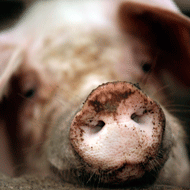
Ohio State researchers track human cases of H3N2 influenza
Shorter pig exhibitions could limit the spread of pig-to-person swine flu at fairs, according to a study led by Ohio State University.
Researchers say that protective measures - including cutting the length of time pigs and people congregate - make good sense for both animals and humans.
Chief among them, said lead researcher Andrew Bowman, is a 72-hour limit to swine exhibitions, which would interrupt widespread flu transmission from pig-to-pig and pigs-to-people.
“Shorter exhibitions don’t eliminate the possibility of the disease spreading, but it can be the difference between a few animals catching the virus and most of them becoming infected,” he said.
Other measures include vaccinating pigs against flu and encouraging those at higher risk of flu complications - such as babies and the elderly - to forego visits to animal exhibits.
In the study, Bowman and his colleagues tracked human cases of H3N2 swine virus-associated with seven agricultural fairs in 2016. They reported 18 cases in Ohio and Michigan after exposure to infected pigs.
Most of these infections caused mild, manageable illness, researchers said. But new flu viruses jumping from pigs to people raises the risk of a flu pandemic.
The work was part of a larger effort to monitor flu virus among exhibition swine in the American Midwest. Regardless of clinical signs, researchers tested pigs at the end of exhibitions. Of the 161 pigs, checked at seven fairs, almost 78 per cent tested positive for the virus. Often there were no observable symptoms of flu.
The researchers found genetically identical flu virus at multiple fairs in Michigan and Ohio. 'This illustrates the rapidity with which this virus, and potentially other pathogens, can move within the highly mobile exhibition swine population,' the authors write.
Bowman added that the H3N2 virus implicated in these transmissions didn’t originate in swine. In fact, people passed the virus to the pigs to begin with, he said.
“As much as we like to point fingers at the pigs, it comes from us too,” Bowman said. “The ease with which viruses can pass between pigs and people and evolve into new, more concerning viruses illustrates the importance of continued monitoring of swine to detect viruses that can threaten animals and people.”
The study, Influenza A(H3N2) Virus in Swine at Agricultural Fairs and Transmission to Humans, Michigan and Ohio, USA, 2016, is published in Emerging Infectious Diseases.



 The RCVS has announced a new version of its 1CPD mobile app, with enhanced features for veterinary surgeons and veterinary nurses to record their continuing professional development.
The RCVS has announced a new version of its 1CPD mobile app, with enhanced features for veterinary surgeons and veterinary nurses to record their continuing professional development.